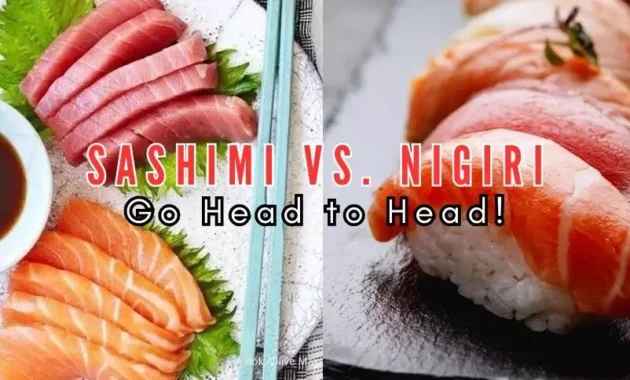If you’re a fan of Japanese cuisine, you’ve probably heard of sashimi and nigiri. While these two dishes may seem similar, there are actually some significant differences between them. In this article, we’ll explore the differences between Sashimi vs Nigiri and why they’re both so popular in Japanese cuisine.
Why are Sashimi and Nigiri popular? Both sashimi and nigiri are incredibly popular in Japanese cuisine for a few reasons:
- Freshness: Because both dishes feature raw fish, freshness is key. In Japan, it’s common for fish to be served the same day it was caught, ensuring that it’s as fresh as possible.
- Flavor: Raw fish has a unique flavor that many people find delicious. When served with the right accompaniments, like wasabi, soy sauce, and ginger, the flavor can be enhanced even further.
- Healthy: Sashimi and nigiri are both relatively healthy dishes, as they’re low in fat and high in protein. They’re also a good source of omega-3 fatty acids, which are important for heart health.
1. What is Sashimi?
Sashimi is a Japanese dish that consists of thinly sliced raw fish served without rice. It’s a popular dish that’s often served as an appetizer or as a main course. Here are some more details about sashimi:
Definition of Sashimi
The word “sashimi” literally means “pierced body” in Japanese. It refers to the traditional method of preparing the fish, which involves piercing it with a sharp knife and then slicing it thinly.

Various Types of Fish Used for Sashimi
Sashimi can be made with a variety of different types of fish, including:
- Tuna: One of the most popular types of fish used for sashimi, tuna has a rich, meaty flavor and a buttery texture.
- Salmon: Another popular option, salmon has a slightly sweet flavor and a delicate texture.
- Yellowtail: Also known as hamachi, yellowtail has a firm texture and a mild, sweet flavor.
- Sea Bream: Known as Tai in Japan, this fish is highly prized for its clean, sweet flavor and soft texture.
- Octopus: Octopus sashimi is chewy and has a slightly sweet, mild flavor.
- Squid: Squid sashimi is also chewy and has a slightly sweet, mild flavor.
Preparation and Presentation of Sashimi
Sashimi is typically prepared by slicing the fish into thin pieces and serving it raw. The slices are usually arranged on a plate in an artful way, with the colors and shapes of the different pieces creating a visually appealing dish.
Sashimi is often served with wasabi, soy sauce, and ginger. Wasabi is a green paste that’s made from the root of the wasabi plant. It has a strong, spicy flavor that complements the mild taste of raw fish. Soy sauce is used as a dipping sauce for the fish, while ginger is often eaten between bites of sashimi to cleanse the palate.
2. What is Nigiri?
Nigiri is another popular Japanese dish that consists of a small hand-formed ball of sushi rice topped with a slice of raw fish or other seafood. The word “nigiri” actually means “squeezed” or “pressed” in Japanese, which refers to the way the rice is formed into a compact shape by the sushi chef’s hands.
Definition of Nigiri
Nigiri sushi is different from other types of sushi, such as maki or temaki, which are wrapped in seaweed. Instead, nigiri sushi consists of two main components: sushi rice and topping, usually a piece of raw fish or seafood.
Various types of fish used for Nigiri
Just like with sashimi, there are many different types of fish and seafood that can be used for nigiri. Some of the most popular options include:
- Tuna (maguro)
- Salmon (sake)
- Yellowtail (hamachi)
- Eel (unagi)
- Shrimp (ebi)
- Octopus (tako)

Preparation and presentation of Nigiri
The preparation and presentation of nigiri sushi is an art form in itself, with sushi chefs dedicating years of training to perfecting their craft. Here’s how nigiri sushi is typically prepared and presented:
- 1. The sushi chef starts by shaping the sushi rice into small oval-shaped balls, using a gentle pressing motion to compact the rice and create a slightly oblong shape.
- 2. The chef then places a small amount of wasabi on top of the rice, which helps to enhance the flavor of the fish and also acts as a natural preservative.
- 3. Finally, the chef adds a slice of raw fish or other seafood on top of the rice, using their fingers to gently press it down and create a seamless, elegant presentation.
Sashimi vs Nigiri: Exploring the Differences Between Two Popular Japanese Dishes
When it comes to Japanese cuisine, Sashimi vs Nigiri are two dishes that are often compared. While they share similarities, there are also notable differences between the two. Let’s take a closer look at the comparison between sashimi vs nigiri.
Differences in preparation methods
- Sashimi: Sashimi is typically thinly sliced raw fish that is served without rice. It is often served with soy sauce and wasabi, and may be accompanied by pickled ginger.
- Nigiri: Nigiri is a type of sushi where a small ball of rice is topped with a slice of raw fish. The fish may be lightly seared or marinated, but it is not cooked. Nigiri is typically served with soy sauce and wasabi, and may also be accompanied by pickled ginger.
Differences in flavor and texture
- Sashimi: Sashimi is all about the fish. The texture and flavor of the fish are the star of the dish, and it is typically served with soy sauce and wasabi to enhance the flavor.
- Nigiri: Nigiri has a different flavor and texture profile than sashimi because it includes rice. The rice is typically seasoned with vinegar and sugar, which adds a slightly sweet and tangy flavor. When combined with the fish, it creates a unique flavor and texture experience.
Nutritional value comparison
- Sashimi: Sashimi is a lean source of protein and is low in fat and calories. It is also rich in vitamins and minerals, including vitamin B12, selenium, and omega-3 fatty acids.
- Nigiri: Nigiri is also a good source of lean protein, but it is higher in calories and carbohydrates due to the rice. However, the rice also adds some additional nutrients, such as fiber and small amounts of vitamins and minerals.
Price comparison
- Sashimi: Sashimi is typically more expensive than nigiri because it requires higher quality fish to achieve the desired texture and flavor.
- Nigiri: Nigiri is often less expensive than sashimi because it uses less expensive cuts of fish and includes rice.
Takeaways
- Both Sashimi vs Nigiri are delicious Japanese dishes, but they have different preparation methods, flavor and texture profiles, nutritional values, and price points.
- If you’re looking for a lean source of protein and want to focus on the flavor and texture of the fish, sashimi may be the way to go.
- If you want a unique flavor and texture experience that includes both fish and rice, nigiri may be a better choice.
- Ultimately, the choice between sashimi vs nigiri comes down to personal preference and what you’re in the mood for.
Sashimi vs Nigiri: Which One Should You Choose?
When it comes to choosing between Sashimi vs Nigiri, there are several factors to consider. Ultimately, it depends on your personal preferences and taste, as well as your health and cost considerations. Here are some things to keep in mind:
A. Factors to Consider
1. Preparation and Presentation
Sashimi is typically served as thin slices of raw fish without rice or other accompaniments, while Nigiri consists of a small ball of rice topped with a slice of raw fish. If you prefer a simpler and more pure taste, sashimi may be the better choice. On the other hand, if you enjoy the combination of rice and fish, nigiri might be more appealing.
2. Flavor and Texture
Sashimi and Nigiri have distinct differences in flavor and texture. Sashimi allows you to fully taste the natural flavors of the fish, while nigiri combines the taste of rice and fish. Additionally, sashimi has a softer texture, while nigiri has a firmer texture due to the rice.
3. Nutritional Value
Both Sashimi vs Nigiri are low in calories and high in protein, making them healthy options. However, Sashimi typically has fewer calories and less fat than Nigiri due to the absence of rice.
4. Cost
Sashimi tends to be more expensive than nigiri due to the higher quality of fish required and the lack of rice as a filler. Nigiri, on the other hand, can be a more affordable option while still providing a satisfying sushi experience.
B. Personal Preferences
At the end of the day, your personal preferences and taste should be the main factor in choosing between Sashimi vs Nigiri. If you enjoy the simplicity of Sashimi and prefer to taste the natural flavor of the fish, then go for it. If you prefer the combination of rice and fish in every bite, then Nigiri might be the better choice for you.
1. Health Considerations
If you are concerned about the nutritional value of your food, sashimi may be the better choice. It is typically lower in calories and fat than nigiri due to the lack of rice. Additionally, if you have a gluten intolerance, Sashimi is a safe option as it is rice-based and does not contain any gluten.
2. Cost Considerations
If cost is a factor, nigiri might be the more affordable option. It typically contains more rice and is therefore a more filling option. However, if you want to splurge on high-quality fish, Sashimi may be worth the extra cost.
In conclusion, both Sashimi vs Nigiri are delicious and healthy options for sushi lovers. The choice between the two ultimately comes down to personal preference, health considerations, and cost.
Conclusion
After learning about the differences between Sashimi vs Nigiri, it’s clear that both are delicious and popular Japanese dishes with their unique features. Here’s a quick summary of what we learned:
- Sashimi is thinly sliced raw fish served without rice, while nigiri is a small ball of rice topped with a slice of raw fish.
- Sashimi emphasizes the purity of the fish’s flavor and texture, while Nigiri offers a balance of flavors and textures between the fish and rice.
- Sashimi is usually more expensive than Nigiri, but it’s also more nutritionally dense.
- When choosing between Sashimi vs Nigiri, personal preferences, health considerations, and cost are all factors to consider.
As for which one is better, that’s entirely up to personal preference! Both dishes have unique characteristics that make them special. We encourage you to try both and decide for yourself which one you prefer.
So whether you’re a fan of Sashimi or Nigiri, or you’re new to Japanese cuisine, we hope this article has helped you appreciate and understand these delicious dishes better.


